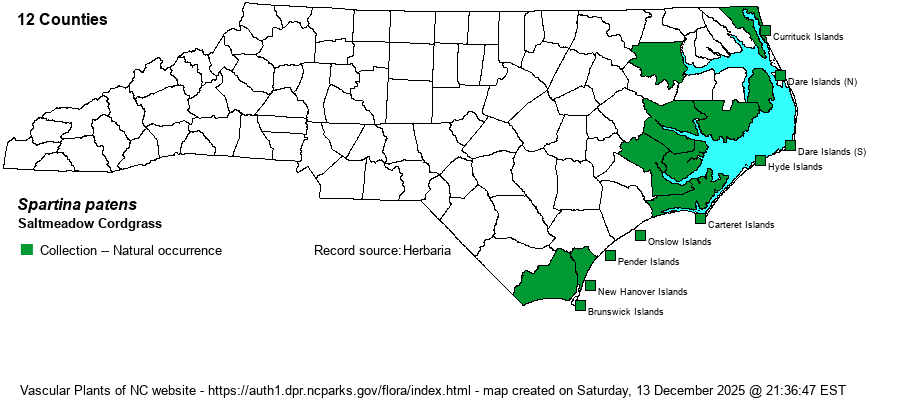| Author | (Aiton) Muhlenberg | |
| Distribution | Outer Banks, barrier islands, and outer Coastal Plain.
Maritime, Newf. to FL and TX; W.I., Mex., C.A. | |
| Abundance | Common, and widespread. Where found, usually abundant or dominant. | |
| Habitat | Brackish marshes, wet maritime grasslands, interdune swales. Also extends into dry maritime grasslands, stable dune barrens, estuarine fringe pine forests, and moist to mesic roadsides. It avoids the wetter portions of marshes. | |
| Phenology | Flowering and fruiting June-September. Note: many populations will show no sign of flowering in any given year. | |
| Identification | This abundant tidewater and seaside grass grows from tough horizontal rhizomes and forms large colonies. The lower leaves are mostly 8 inches to 1.5 feet long and are usually involute (rolled tightly lengthwise). Flowering stems usually grow 2-3 feet tall, with 2-10 strongly ascending spikes. However, in many places, one sees only rather "flattened" mat-like or wave-like stands of plants, as if they had been recently flooded or pushed down by hurricane force winds! | |
| Taxonomic Comments | Most of our plants are the entity named Spartina patens var. monogyna, based on a rapid search through specimens at NCU in 2022. Specimens of the more northern var. patens were noted from Bertie, Craven, Currituck, and Dare counties.
| |
| Other Common Name(s) | Saltmarsh Hay, Marsh-hay Cordgrass | |
| State Rank | S5 | |
| Global Rank | G5 | |
| State Status | | |
| US Status | | |
| USACE-agcp | FACW link |
| USACE-emp | FACW link |

